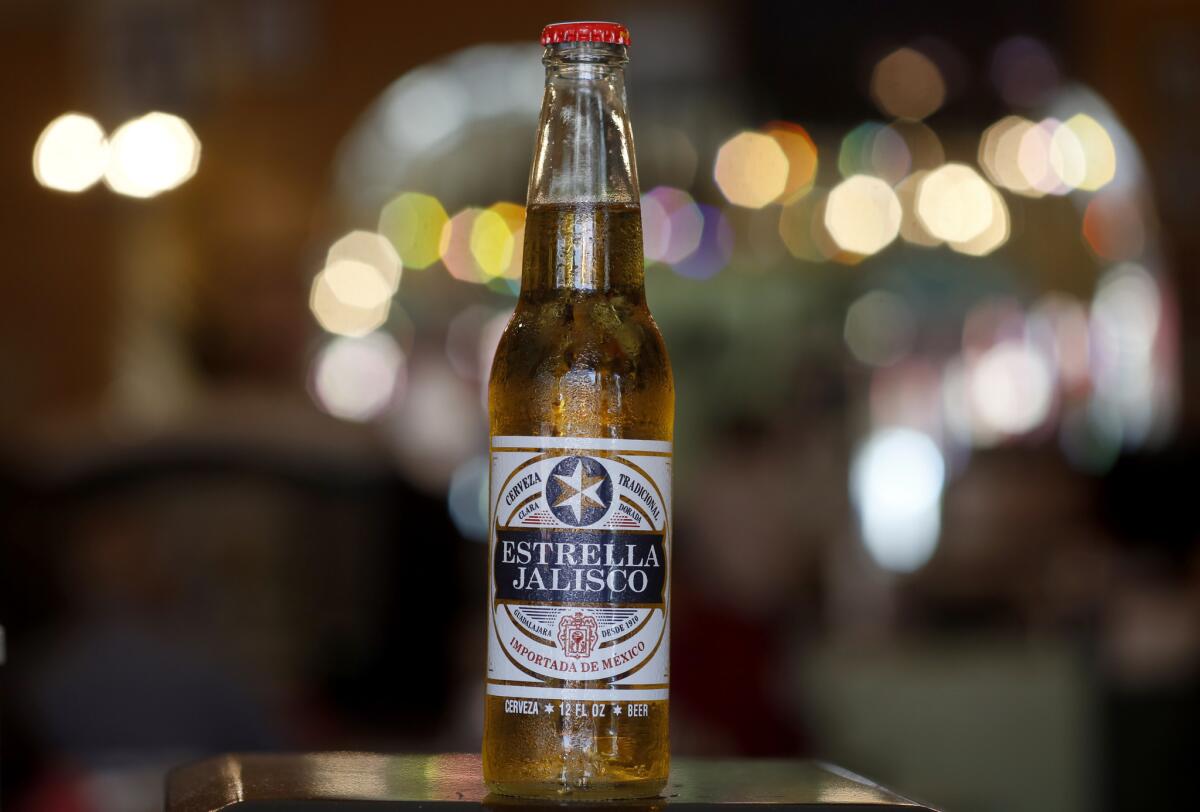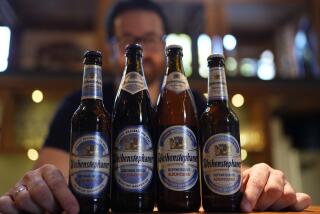Anheuser-Busch brings another Mexican beer to U.S., betting on immigrants’ hometown loyalty

- Share via
The first time Michael Price saw a bottle of Estrella Jalisco beer, at a liquor store near his home in Bell Gardens, the 26-year-old immediately texted his friends. “I told all my buds, look, check it out, they got Estrella,” he says. “It was a pretty big deal because you could only get it in Jalisco.”
Price, a bartender at Five Star Bar in downtown Los Angeles, says many of his friends are from Guadalajara, the capital of Jalisco state in Mexico, where Estrella Jalisco is made. Until March, the beer could not be found in the United States.
Anheuser-Busch InBev is betting on that hometown loyalty. The world’s largest brewer introduced Estrella Jalisco this spring in a bid to grab a piece of the U.S. beer market that it hasn’t dominated: Mexican imports.
Forced to give up the rights to market Corona and other big-selling Mexican brands here three years ago, as part of its purchase of Grupo Modelo, Belgian-based Anheuser-Busch has had to improvise.
For now, instead of trying to mass-market Estrella or another Mexican import, Anheuser-Busch is using it to target people who have roots in the part of Mexico that sends the most people north.
There were 34 million people of Mexican origin living in the United States in 2012, according to the Pew Research Center. In 2014, 1 in 4 migrants from Mexico were from Jalisco, Michoacan, or Durango, all western or central western states, according to the nonprofit Migration Policy Institute.
“For people from the center-west part of Mexico, their parents grew up with that beer. There is such a powerful element of heritage and authenticity,” said Jorge Inda Meza, marketing director of the western region for Anheuser-Busch.
“We know that’s really powerful to first-generation Mexicans, and also to second- and third-generation Mexicans who are trying to express their heritage,” he said.
Industry analysts are skeptical that Anheuser-Busch can carve out a significant market with a niche beer such as Estrella. For one thing, it tried something similar two years ago with limited success.
But the latest effort is a sign that Mexican beer, which has been outselling other imports and mainstream domestic brews for the last few years, has become too profitable for even the wealthiest companies in the industry to ignore.
In 2015, sales of foreign beers in the U.S. rose 11% while beer sales overall remained relatively flat. Modelo increased sales a startling 25% last year while Corona and Dos Equis, which is owned by Heineken, also saw sales increase by double digits, according to IRI, a market research firm.
See the most-read stories this hour »
Modelo and Corona alone accounted for nearly half the $5.5 billion in import beer sales last year.
“In the last five years you have had two growth engines: craft and Mexican beer. Mainstream brands have suffered,” says Eric Shepard, the executive editor of Beer Marketer’s Insights, a trade publication that analyzes sales statistics. “Anheuser Busch is overrepresented in nongrowth segments.”
Shepard said 3% of Anheuser Busch’s sales volume comes from imports and 1% comes from craft beers.
In the compromise struck in 2013 with the U.S. Justice Department over the Modelo deal, Anheuser-Busch sold the rights to Corona, Modelo and Pacifico beer to Constellation Brands, whose sales have more than doubled and profit has nearly tripled since then.
But if Anheuser-Busch is jealous, it claims at least to have no interest in trying to replicate Constellation’s beer portfolio. The company is using Estrella to home in on a very specific group of Mexican consumers, and says it has no immediate plans to make a play for a broader audience.
Estrella debuted in markets with substantial communities of Mexicans from that country’s Pacific coast, including California, Nevada and Texas; in chains that are popular with Mexicans, such as La Superior and Vallarta supermarkets; and in neighborhood Mexican restaurants.
Ricardo Flores, head chef at Birrieria Chalio, a colorful haunt in East Los Angeles, says he ordered Estrella in March. At first he could only sell one case, which has 24 bottles, per week.
But after about a month, he put out Jalisco-branded flyers that proclaim, “this is Mexicanidad,” a term that refers to Mexican identity, and sales started to pick up. Now the restaurant goes through two cases a week, which is about half of what it sells of Corona and Modelo.
“It’s catching on,” said Maria Luis, whose family owns the restaurant. “I think it could sell like Corona. Corona is still the queen, but they’re asking for [Estrella Jalisco] a lot.”
Anheuser-Busch sold 82,000 cases of Estrella from March through May 15, according to IRI data.
But some analysts are skeptical that such idiosyncratic marketing will pay off in the long run.
Giving people another craft-like option may not be a recipe for success, they say, since the draw of Mexican imports has been that they are as light and drinkable as mainstream domestic beers, but taste better.
“The average consumer is overwhelmed with the selection and if they need to pick up a six pack for a party, Corona is safe,” says Townsend Ziebold, an investment banker at First Beverage Group, a financial firm based in Los Angeles that focuses on beverages. “If their strategy is to make this a niche beer, that doesn’t sound like something that moves the dial.”
Two years ago, Anheuser-Busch rolled out another Mexican brew, Montejo, at Dodger Stadium, also targeting Mexican and Mexican American drinkers. Montejo hasn’t won them over yet. Sales dropped over the last year, with Anheuser-Busch selling 236,362 cases from January through May 15 compared with 278,197 in the same period of 2015.
Inda Meza says that Montejo’s problem may be that it comes from the Yucatan, which sends fewer Mexicans to the U.S. than the western side of the country.
“What makes us optimistic is that it taps into an emotional space, a powerful space which is a piece of home,” Inda Meza said. “A lot of people go away and they long for the memories of home.”
MORE BUSINESS NEWS
Diversity takes center stage at Airbnb’s annual tech conference
With 60 theme parks planned in China, here’s how Shanghai Disney plans to compete
Millions of Twitter users’ information reportedly stolen but breach denied
Follow me @NatalieKitro on Twitter
More to Read
Inside the business of entertainment
The Wide Shot brings you news, analysis and insights on everything from streaming wars to production — and what it all means for the future.
You may occasionally receive promotional content from the Los Angeles Times.











